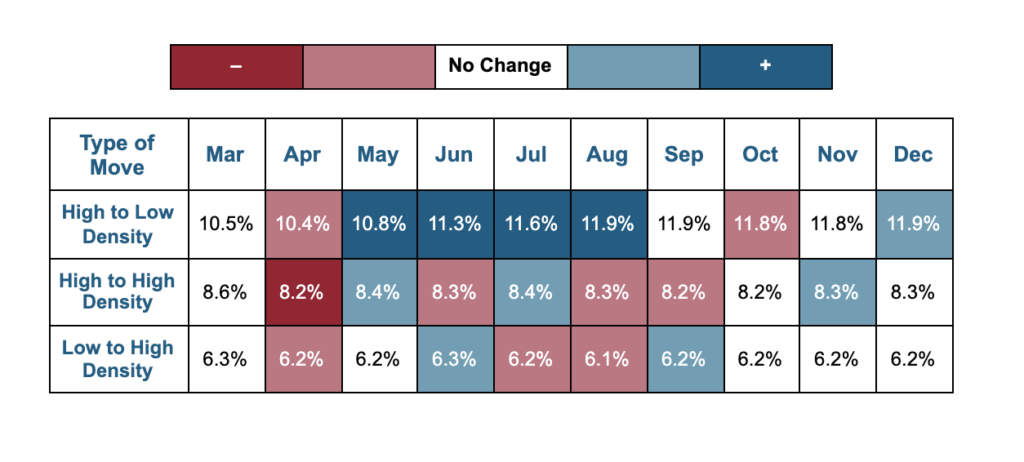
13 Apr What Today’s Talent Migration Really Means for Small to Mid-Sized Cities: Part I
Part I: As Talent Goes, So Goes the City
For every economic development organization across the nation, talent recruitment represents an odd exercise in arithmetic. What begins as a matter of addition — how do we get more people to work in our community? — can quickly turn into an advanced calculus problem — when does the cost of attracting each additional worker begin to outweigh the benefit to our community?
Fortunately, current conditions mean that most economic developers are dealing primarily with an addition or subtraction problem, which is not to say that it’s an easy problem to solve. At this highest level of talent recruitment dynamics, recent anecdotal evidence and media narratives have latched onto the outmigration of talent from the big city to the suburb or small town (communities with populations in the tens or low hundreds of thousands) as the “next big thing.” During the COVID-19 pandemic, thousands of well-educated urbanites saw the advantages of big city life evaporate, leaving them to work remotely in cramped spaces while their hometown friends frolicked in fields and kayaked local creeks. So, armed with permanent markers and packing tape, they filled U-Haul trucks with boxes of their belongings to begin a new life, preferably somewhere with a bit more room between themselves and their neighbors. The temporary shutdown of offices, bars, concert venues, and sports arenas meant that parks, trails, and backyards became all the rage, luring younger generations out of apartment buildings and into single-family homes. Or so the story goes…
Something is a bit too clean about this narrative, its logic almost too appealing. This alleged exodus from the big city feels like a much-needed victory for small cities and towns, and it’s a timely release for cities facing housing shortages, failing schools, and service deficiencies. Even society’s storytellers have begun to incorporate the theme into their art with great success. What are Taylor Swift’s Grammy-winning folklore and the CW’s Superman & Lois if not exaltations of a back-to-basics lifestyle that rejects the hustle and bustle of New York City and Metropolis?
Don’t get us wrong, as place marketers for small- and medium-sized communities, this narrative implies a great opportunity for the economic development organizations that we want to empower. However, as place researchers, we like to rely on a larger collection of empirical evidence that includes anecdotes and hard numbers before trying to build a cohesive story. So yes, that means more math.
In late 2019, the U.S. Census Bureau estimated that only 9.8% of Americans moved the previous year, the lowest percentage ever reported. In 2020, the Bureau reported that year’s figure as 9.3%. Once again, historically low. So on a macro level, not much has changed.
For a better approximation of what’s going on, researchers have turned to data sources ranging from the expected to the unconventional. Stephan Whitaker, an economist at the Federal Reserve Bank of Cleveland, utilized the Consumer Credit Panel to survey over 10 million U.S. adults to measure net migration from urban areas. Of the two components to net migration (people moving out and people moving in), Whitaker found that, yes, there was an increase in the number of people leaving the nation’s largest cities in 2020. But there was an even more significant decrease in the number of people moving into big cities to offset the losses. The result is net out-migration that looks dramatic, both on paper and in the extended vacancies in urban neighborhoods, because the young people and immigrants that usually take the place of exurbanites just didn’t show up.
Speaking of appearances, one of the recurring visuals of this migration narrative is the suburb- or rural-bound U-Haul. And if you wondered whether that trend could be quantified, real estate investor Eric Martel did just that. Replicating another researcher’s work from 2018, Martel measured one-way U-Haul truck rentals in 2020 by way of the company’s dynamic pricing model. U-Haul effectively uses “surge” pricing in response to high demand in a particular city, making it possible to determine migration patterns based on where U-Haul prices are higher or lower. The findings were consistent with the assertion that big cities lost residents in 2020, but less conclusive overall. Some large centers of out-migration like San Jose and Oakland show little change from two years ago; others like Los Angeles and Chicago show more U-Hauls headed out than in, but in smaller numbers. If there are any winners in Martel’s data, it’s large cities in the Sun Belt like St. Petersburg and San Antonio — not exactly the idyllic small towns we were picturing.
There are, as always, numbers to help tell us why the opportunity to attract talent isn’t exclusive to smaller cities and towns. Economists Rebecca Meeker and Nuno Mota at Fannie Mae analyzed the purchase mortgage applications of first-time homebuyers to determine where they were moving from and where they wanted to invest their future. They introduce another measurement to capture the migration trend, classifying each move as one of three types: from a high-density area (urban, mostly multi-family units) to a low-density area (suburban or rural, mostly single-family units); from a high-density area to another high-density area; and from a low-density area to a high-density area. Their figures for each of these types of moves for last 10 months of 2020 (the pandemic period) are below:

The most notable change is a late spring and summer increase in the percentage of first-time homebuyers applying to move into a low-density area from a high-density area. However, before accepting this as confirmation of the media’s migration narrative, there are some caveats: Meeker and Mota define low-density zip codes as “predominantly single-family” or “where driving to work is the norm.” While smaller cities and towns certainly meet the criteria, so do certain zip codes in sprawling and very populous cities — like the Sun Belt metros mentioned earlier. Additionally, the percentage of first-time homebuyers looking to move to high-density areas remained fairly steady, meaning that the pandemic didn’t necessarily make people reconsider buying into urban neighborhoods. Rather, it has nudged a sizable group of people — who, before March of 2020, may have thought about moving only in vague terms — to become first-time homebuyers in low-density areas, thereby accounting for nearly all of the increase in relocation by these types of homebuyers.
So, if the talent migration narrative isn’t as clear-cut as the headlines, can we learn anything about where the trends are headed? Maybe. Some things won’t change: the top tier cities with recognizable initialisms — NY, DC, ATL, CHI, LA, SF — will always have their appeal, accrued over generations of history and pop culture references. Their populations are constantly churning, a prerequisite for the kind of reinvention and rejuvenation that is part of their very character. Some things will change: people started moving into Sun Belt cities at a faster rate during the last decade, and that has only been accelerated by the pandemic. Because they grew more recently, these cities are far less dense and designed with the family in mind. They have the big houses and yards that exurbanites seem to want; they are starting to build dense urban centers to increase housing diversity; and, crucially, they also have the professional sports, large event venues, and restaurant scenes that we categorize as big city amenities. These cities stand in direct competition with each other and with the small cities and towns that we would like to see benefit most from a redistribution of talent.
Still, small cities and towns are by no means on the outside looking in. If space is what matters, they have the upper hand. If money talks, they offer a more affordable lifestyle. And if opportunity beckons, they are the places where financial and emotional investment goes furthest. At North Star, we want to see whether these factors do, in fact, give small cities and towns a leg up in recruiting talent that is free from the tethers of corporate offices and diminutive one-bedrooms. With the help of our research partners at Qualtrics, we will ask people who made the move to a smaller metro about their motivations and experiences with the process. At the completion of this study, we hope to share insights that help focus and strengthen the way you market your community to talent in the face of these somewhat new migration trends.
